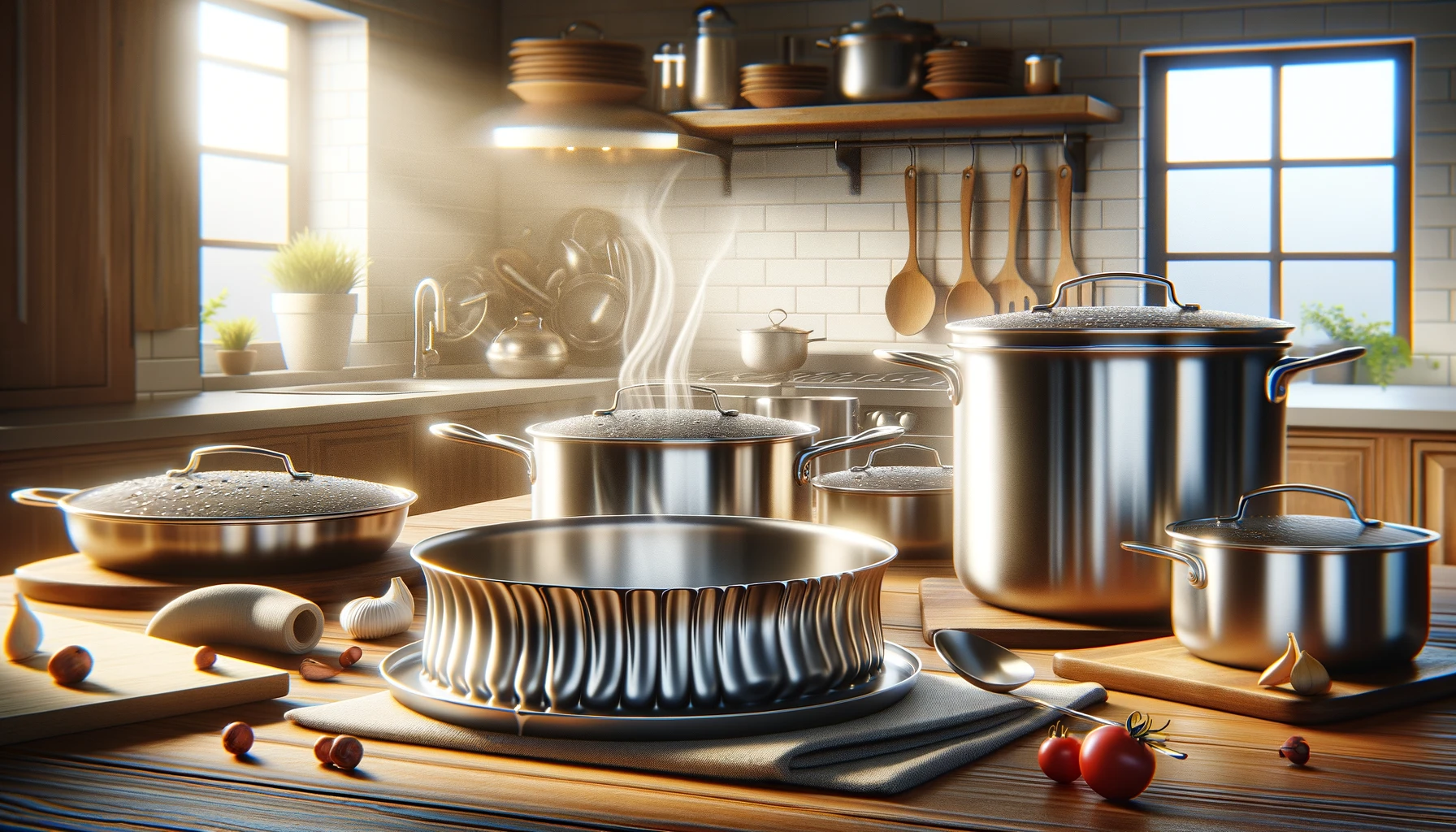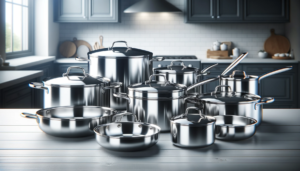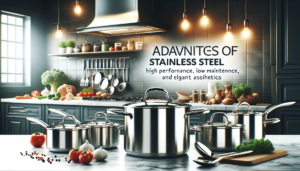Have you ever noticed the bottoms of your shiny stainless steel pots and pans slowly morphing from flat to rippled waves?
Warping is a common occurrence in stainless cookware.
While stainless steel cookware is prone to warping from uneven heating, material quality, and thickness issues, proper cooking methods and care can reduce deformation risks substantially.
Let’s examine what causes warping in stainless steel pans, preventative measures to maintain flat bases, and options if pans still warp.
Does Stainless Steel Cookware Warp?

Yes, stainless steel cookware can and does warp from repeated or uneven heating.
The lower conductivity of stainless steel makes it prone to developing hot spots and subsequent warping during regular cooking usage over time.
Poor quality stainless steel grades lacking durability increase this risk further.
While warping potential cannot be fully eliminated given the properties of stainless steel, choosing high-end cookware and utilizing proper care methods can substantially reduce deformation issues.
Now let’s explore the common causes of warping in more depth, as well as preventative measures and solutions for existing warps.
What Causes Warping In Stainless Steel Cookware
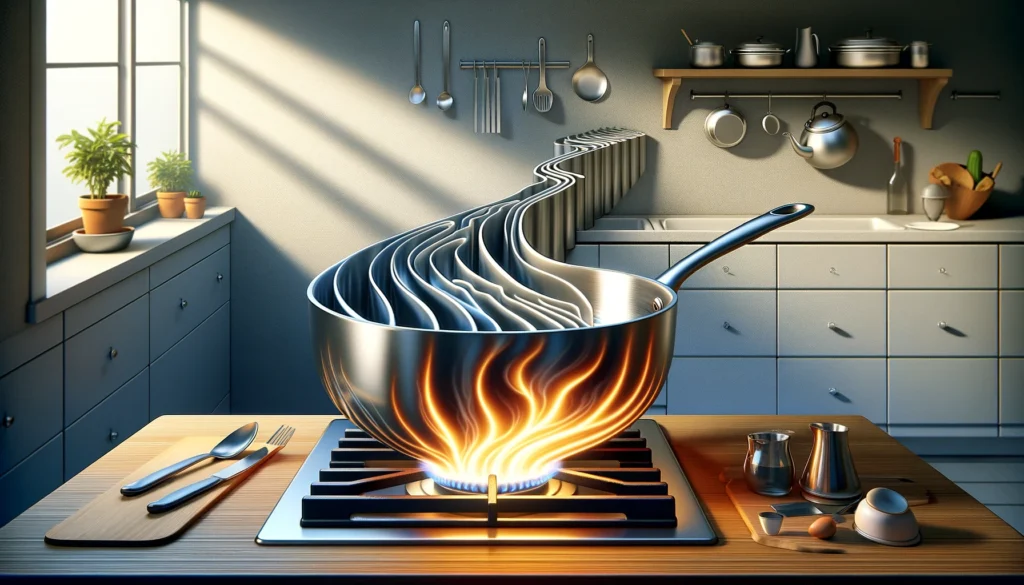
There are a few key reasons that stainless steel pans and pots may develop warps and uneven bases over time.
The primary cause of warping is uneven or rapid heating that creates temperature differentials across the surface of the pan.
Stainless steel is not as conductive as metals like copper and aluminum, so it tends to heat up rather unevenly.
This means that placing stainless steel cookware over high heat or subjecting only portions of the pan to direct heat can lead to some areas expanding much faster than others.
One part of the pan may become extremely hot while the surrounding area remains significantly cooler.
This contrast in temperature from one region to the next subsequently causes the hotter portion to expand rapidly compared to the rest of the pan.
As this happens repeatedly over time, the pressure induces the hotter zone to distort.
The more malleable grade of stainless steel will gradually deform and stretch longer than the surrounding metal, resulting in a visible warp or bubble in the pan base.
Another factor that may make stainless steel pans more prone to warping is the use of cheaper stainless steel grades with lower nickel content or other imperfections in quality.
Not all stainless steel alloys provide equivalent durability and high temperature resistance.
Less expensive cookware is often made with stainless steel alloys that have lower nickel levels in order to keep costs down.
However, nickel plays an important role in making stainless steel more resilient against heat induced warping.
Higher percentage nickel stainless steel does a superior job withstanding the repetitive expansion and contraction at high cooking heats without losing its form.
Imperfections in cheaper steel caused by oxygen, poor melting practices, or inadequate finishing processes also potentially make pans more inclined to warp eventually.
Luxury cookware brands generally rely on higher-grade, higher-nickel stainless steel that exhibits enhanced warp resistance during daily cooking usage.
Insufficient thickness can also leave stainless steel cookware more vulnerable to warping issues over time.
Thin pans lack interior metal mass to retain and spread heat effectively across their base surface area.
Sudden temperature fluctuations or inconsistencies are therefore more likely to impact thinner pans in uneven ways.
This puts greater stress on thinner pans during the repeated expansion and contraction cycles of stovetop cooking sessions.
Thinner pans also simply have less sheer structural strength and resilience against forces trying to bend them permanently out of shape.
Heavy stainless steel pans featuring thicker bottoms provide more protection, as the additional metal gives them better thermal properties and makes them more rigid.
The deficiencies of stainless steel regarding low conductivity get partially offset by increased thickness, making heavy pans less prone to base deformities.
Factors That Reduce Risk Of Warping
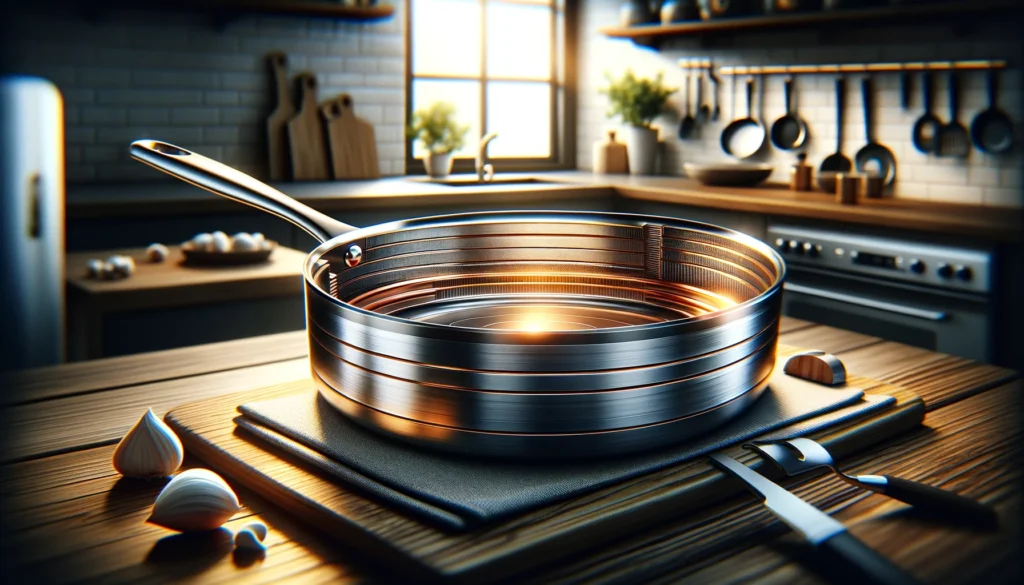
Opting for high quality fully clad stainless steel cookware is one of the most reliable ways to reduce warping risks.
Fully clad construction sandwiches an inner core layer of highly conductive metal like pure aluminum or copper between exterior stainless steel layers.
The interior core layer, such as 5mm of copper or aluminum, enables excellent heat distribution across the entire pan surface.
This prevents hot spots from forming in stainless steel over direct burner flames.
With a fully clad pan, heat transfers efficiently from the conductive inner core out towards the external stainless sides.
No portion of the pan gets radically hotter than any other portion.
So when expansion occurs during heating cycles, it takes place evenly everywhere instead of isolated zones expanding faster than others.
Quality clad cookware effectively minimizes the likelihood of temperature differentials leading to warped pan bottoms over time.
Another factor that makes stainless steel pans dramatically more warp-resistant is thicker, heavier pan construction with extra metal mass concentrated on the bottom.
Particularly when combined with cladding, adding thickness in the form of a heavy gauge base allows stainless steel cookware to resist warping issues exceptionally well.
The thicker the cookware base, the more heat energy it can absorb and retain at once.
More metal mass leads to better stability and graduality instead of sudden spikes or drops during heating and cooling off periods.
Thick bases allow gradual, even warming and cooling to happen instead of intense temperature fluctuations occurring rapidly.
This protects the structural integrity of the entire pan so it remains flat.
Heavy bases also lend additional reinforcement against physical impacts as well as improved resilience if pans get overheated.
Premium tri-ply stainless steel cookware typically features extremely thick, heavy-duty bases that prevent warping better than thin pans which are far more vulnerable.
Taking proper precautions to preheat stainless steel pans gradually can further help prevent warping by avoiding sudden temperature shocks.
One of the benefits of quality heavy pans is how they can be slowly brought up to temperature at lower burner heat settings without scorching food.
Thinner pans often require cranking up the heat rapidly to full in order to warm the pan at all.
But blasting thin metal over high flame can inadvertently create turbulence in temperature consistency.
Preheating over medium or medium low instead allows time for heat to spread calmly throughout the pan so everything expands together.
Starting with a lower preheat also means you are not shocking the internal aluminum or copper core by immediately subjecting it to intense fire.
Fully clad stainless steel cookware preheated patiently over moderate burner heat undergoes far less radical temperature shifts, leading to minimal warping issues during the warm-up process.
Tips To Prevent Warping
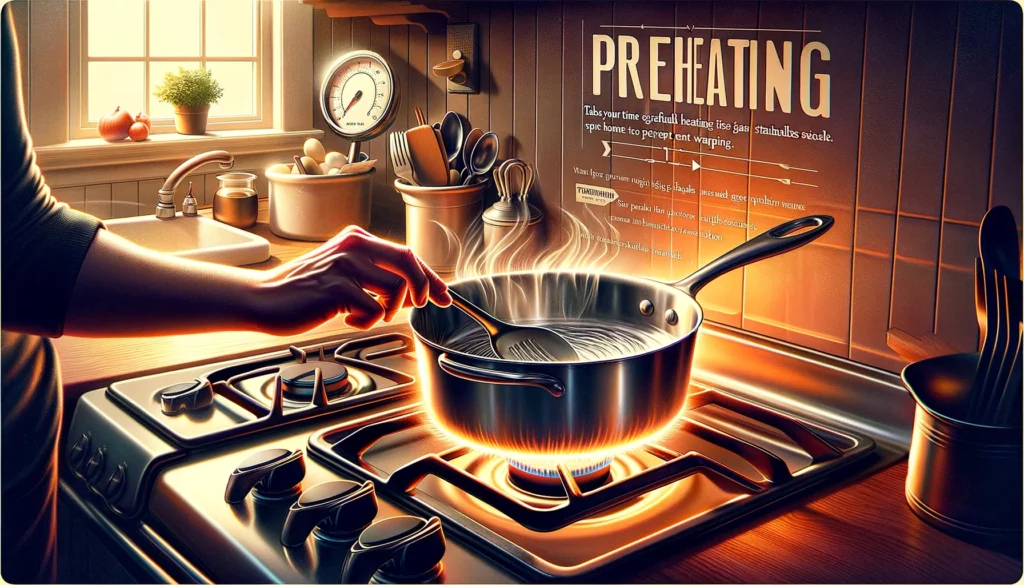
One of the most reliable tips to prevent stainless steel pans from warping is avoiding sudden temperature changes whenever possible.
Exposing hot pans to abrupt shifts between temperature extremes can readily cause warping even in higher quality stainless steel cookware.
Plunging an extremely hot pan into a sink full of cold water essentially causes portions of the metal to want to contract rapidly while other areas remain expanded from residual heat.
These opposing forces pull on the pan structure unevenly, making it very possible for warps to occur.
Similarly, pouring cold liquid into a hot empty pan subjects the base metal to uneven cooling effects.
For optimal results, stainless steel pans should be allowed to cool gradually to room temperature before washing.
Thermal shocks are more likely when there is a more profound temperature difference, so avoiding big, hasty shifts up or down is wise.
It is also best practice for home cooks to use primarily low or medium burner heat settings when cooking with stainless steel pans.
Cranking pots or pans over high flame exacerbates stainless steel’s innate tendency to create hot spots and heat inconsistently.
The excessive intensity of high heat applied to stainless steel’s relatively poor conductivity essentially ensures dramatic temperature variation across any pan surface.
Even quality tri-ply cookware will develop wildly hot zones directly above flame contact points compared to areas near pan edges when exposed to extreme heat differentials.
Preheating over low or starting dishes over medium settings gives the best cooking control.
Food is less likely to scorch arbitrarily in certain spots because burner heat gets distributed calmly at lower intensities instead of channeled into highly concentrated hot zones.
Keeping pans generally under lower intensity flame also puts less repetitive stress on metal from expanding and contracting intensely at the highest highs and lowest lows.
Allowing stainless steel pans to cool fully before cleaning them is another simple habit that can help prevent warping issues stemming from temperature shock.
Empty hot pans removed directly from the stove burner retain extremely high residual heat energy for quite awhile even after cooking ceases.
Quickly introducing room temperature water into a hot emptied pan causes uneven cooling contraction effects in the metal, increasing chances of warping the pan bottom.
Far better to let the entire pan cool down gradually to room temperature first before adding any water or soap and creating sudden cooling.
Ideally pans should air cool significantly or at least be given several minutes under running water to bring down their temperature gently before washing.
Drastic heat changes encourage warps; consistent cooling does not.
Hand washing stainless steel pans rather than machine washing protects pans better too since the extreme heat of dishwasher drying cycles tends to exacerbate stainless steel’s natural uneven heating tendencies.
Dishwashers that rely on very high heat without precise temperature regulation basically blast pans in circulation with hot air, a prime scenario for warping.
Sudden surges of heat impact various portions of stainless steel pans differently, leading those sections to expand rapidly compared to the rest of the pan.
Over many dishwasher cycles, the cumulative effect of inconsistent high heat paired with stainless steel leads increasingly to base deformation issues.
For anyone hoping to preserve attractive flat-bottomed stainless steel pans for optimal cooking performance, hand washing pans is really essential.
What To Do If Your Pan Warps
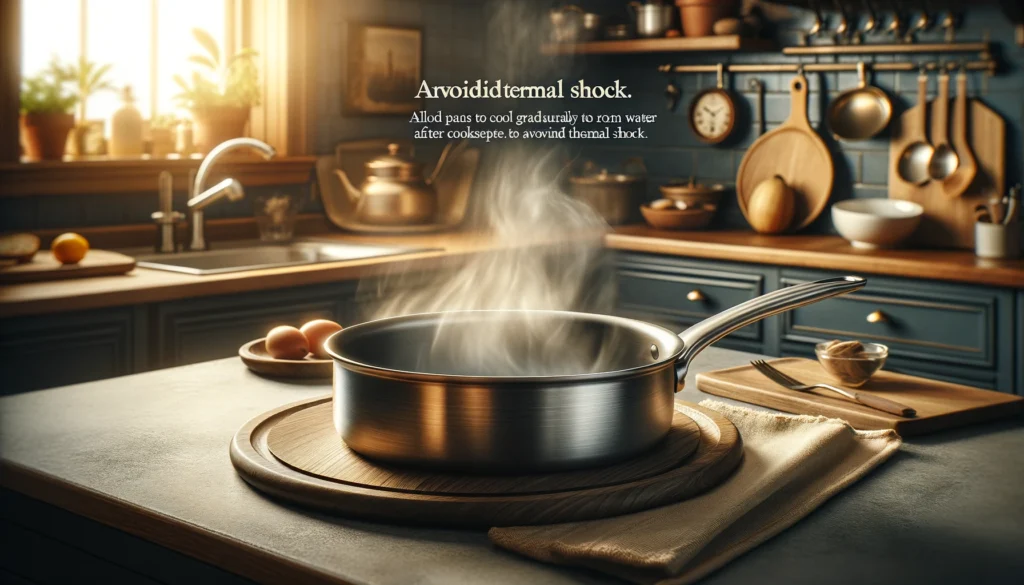
If you discover that your stainless steel pan has developed a slight but noticeable warp in spite of your best care efforts, there are some things you can try at home to fix it.
One common recommendation is to attempt re-forming the pan bottom while the pan metal is still hot and malleable enough to be gently pressed back into shape.
Place a protective hot pad, oven mitt, or folded towel inside the inverted pan, then position some cans, books, or other sturdy kitchen items on top to weigh it down.
Check frequently and allow the added heat and weight to work in conjunction over 10-20 minutes to gently re-level a very shallow warp.
Success depends on the grade of stainless steel and severity of warping, so results vary.
But many people have been able to press out minor warps detected soon after they form using this method.
Pans with more pronounced warping that resists re-forming efforts typically need to get replaced for optimal cooking functionality.
Badly warped stainless steel pans may still work reasonably well for simmering liquids, serving foods, holding ingredients, or other tasks not wholly dependent on maintaining continuous contact with the stovetop surface.
But moderate to substantial warping on pan bottoms lead to uneven burner contact and terrible heat distribution for purposes of searing, frying, simmering, etc.
Too much warp makes it essentially impossible to properly cook over direct heat, as stainless steel’s deficiencies quickly multiply.
At that point it is generally advisable replace warped pans with new ones that lay flat across burners.
Even expensive, high quality tri-ply stainless steel pans that become significantly warped over time fail to provide proper cooking performance due to the broken connection with heat transferring into and across the pan base.
Conclusion
In conclusion, stainless steel cookware can definitely warp from uneven heating, low-quality materials, insufficient thickness, or improper usage.
However, opting for fully-clad tri-ply construction with heavier gauges, proper preheating methods, avoiding thermal shocks, and handwashing can dramatically reduce warping risks.
Paying attention to quality and cookware care does make a difference.
If pans do warp slightly, quick at-home re-forming tricks may rectify the issue.
But more substantially warped pans likely need replacement for optimal cooking functionality.
